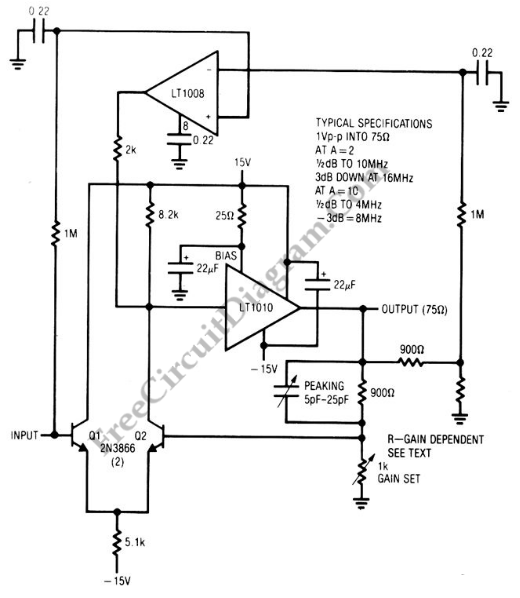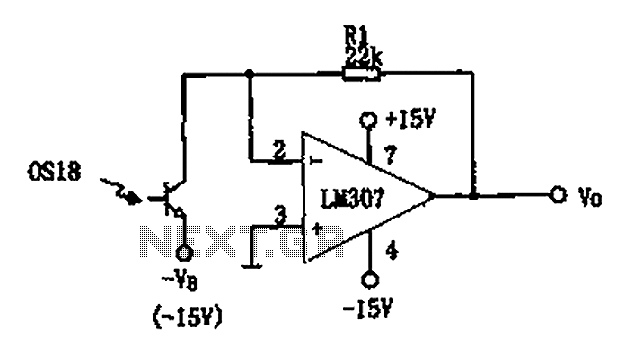
500W power inverter circuit diagram

This is the schematic diagram of a 500W power inverter circuit built using 10 pieces of well-known NPN power transistors, 2N3055, to amplify the AC signal produced by a multivibrator. The frequency generator/multivibrator is also constructed using transistors. All components are readily available. The inverter converts a 12V DC battery (commonly a car battery) into 220-240V AC power. The inverter is powered by 6 pairs of TIP35C transistors connected in parallel, totaling 12 TIP35C transistors. There is only one variable resistor in this circuit. Additionally, there is a circuit diagram for an inverter designed to drive an 8W fluorescent lamp from a 12V source, built using a ZTX652 transistor. This inverter operates with a DC supply ranging from 10V to 16.5V, achieving efficiencies of up to 78%, making it suitable for various applications. The schematic diagram for a 100W inverter circuit is also available, which converts a 12V DC input to a 220V AC output. This circuit is based on the IC CD4047 to generate a sine wave signal at 50Hz, with the power transistor 2N3055 boosting the signal to achieve higher power (higher electric current). Furthermore, a 250W inverter circuit is designed to convert a 12V DC input from a car battery, providing either 120V AC or 220V AC output depending on the transformer used, operating at a frequency of 60Hz. The operation of the inverter circuit is straightforward, with the timer IC 555 generating a 120Hz signal.
The 500W power inverter circuit utilizes the 2N3055 transistors, which are known for their high current handling capabilities, making them suitable for power amplification in this application. The multivibrator, which serves as the frequency generator, can be implemented using a pair of transistors configured in a feedback loop to produce a square wave output. This square wave is then transformed into a sine wave using an LC filter or transformer, depending on the design requirements.
In the case of the 100W inverter circuit, the use of the CD4047 integrated circuit allows for precise frequency control and stability, generating a sine wave output that is then amplified by the 2N3055 transistors. The circuit's efficiency is critical, and the design aims to minimize losses in the power conversion process, ensuring that the output voltage remains stable under varying load conditions.
The 250W inverter circuit demonstrates versatility in output voltage based on transformer selection, thus allowing for adaptability in various applications. The inclusion of a timer IC 555 for generating a 120Hz signal is an efficient way to control the switching of the transistors, providing a reliable operation for the inverter system.
Overall, these inverter designs showcase practical applications of transistor-based circuits for power conversion, highlighting the importance of component selection, circuit topology, and efficiency in achieving desired performance levels.This is the scheme diagram of 500W power inverter circuit which build using 10 pieces of well-known NPN power transistor 2N3055 to amplify the AC signal produced by multivibrator. The frequency generator / multivibrator is built based on transistors too. All of the components is easy to gathered from the. This is the 500W power inverter circuit, converting a 12VDC battery (usually car battery) to become 220-240V AC power. The inverter is powered using 6 pairs of transistor TIP35C which connected in parallel, so it will be 12 TIP35C transistors. There is certainly only one variable resistance in this circuit. This is the circuit diagram of inverter for 8W fluorescent lamp. The circuit is build based ZTX652 transistor, and used to drive an 8W fluorescent lamp from a 12V source.
The inverter will work from 10V to 16. 5V DC supply, attaining efficiencies up to 78% thus making it suitable for. Here the schematic diagram of 100W Inverter Circuit which will convert 12VDC input to be 220VAC output. The circuit built based IC CD4047 to generate sine wave signal 50Hz and then the power transistor 2N3055 will boost the signal so that the signal have high power (high electric current).
Then. This 250W inverter circuit converts the 12V DC input from car battery. The output will be 120V AC or 220V AC depended on the transformer used. The inverter work at 60Hz frequency. The inverter circuit operation is very simple. The IC1 (timer IC 555) will generate a 120-Hz signal. Then. We aim to transmit more information by carrying articles. Please send us an E-mail to wanghuali@hqew. net within 15 days if we are involved in the problems of article content, copyright or other problems. We will delete it soon. 🔗 External reference
The 500W power inverter circuit utilizes the 2N3055 transistors, which are known for their high current handling capabilities, making them suitable for power amplification in this application. The multivibrator, which serves as the frequency generator, can be implemented using a pair of transistors configured in a feedback loop to produce a square wave output. This square wave is then transformed into a sine wave using an LC filter or transformer, depending on the design requirements.
In the case of the 100W inverter circuit, the use of the CD4047 integrated circuit allows for precise frequency control and stability, generating a sine wave output that is then amplified by the 2N3055 transistors. The circuit's efficiency is critical, and the design aims to minimize losses in the power conversion process, ensuring that the output voltage remains stable under varying load conditions.
The 250W inverter circuit demonstrates versatility in output voltage based on transformer selection, thus allowing for adaptability in various applications. The inclusion of a timer IC 555 for generating a 120Hz signal is an efficient way to control the switching of the transistors, providing a reliable operation for the inverter system.
Overall, these inverter designs showcase practical applications of transistor-based circuits for power conversion, highlighting the importance of component selection, circuit topology, and efficiency in achieving desired performance levels.This is the scheme diagram of 500W power inverter circuit which build using 10 pieces of well-known NPN power transistor 2N3055 to amplify the AC signal produced by multivibrator. The frequency generator / multivibrator is built based on transistors too. All of the components is easy to gathered from the. This is the 500W power inverter circuit, converting a 12VDC battery (usually car battery) to become 220-240V AC power. The inverter is powered using 6 pairs of transistor TIP35C which connected in parallel, so it will be 12 TIP35C transistors. There is certainly only one variable resistance in this circuit. This is the circuit diagram of inverter for 8W fluorescent lamp. The circuit is build based ZTX652 transistor, and used to drive an 8W fluorescent lamp from a 12V source.
The inverter will work from 10V to 16. 5V DC supply, attaining efficiencies up to 78% thus making it suitable for. Here the schematic diagram of 100W Inverter Circuit which will convert 12VDC input to be 220VAC output. The circuit built based IC CD4047 to generate sine wave signal 50Hz and then the power transistor 2N3055 will boost the signal so that the signal have high power (high electric current).
Then. This 250W inverter circuit converts the 12V DC input from car battery. The output will be 120V AC or 220V AC depended on the transformer used. The inverter work at 60Hz frequency. The inverter circuit operation is very simple. The IC1 (timer IC 555) will generate a 120-Hz signal. Then. We aim to transmit more information by carrying articles. Please send us an E-mail to wanghuali@hqew. net within 15 days if we are involved in the problems of article content, copyright or other problems. We will delete it soon. 🔗 External reference





